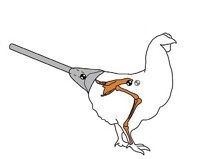Advertisement
Grab your lab coat. Let's get started
Welcome!
Welcome!
Create an account below to get 6 C&EN articles per month, receive newsletters and more - all free.
It seems this is your first time logging in online. Please enter the following information to continue.
As an ACS member you automatically get access to this site. All we need is few more details to create your reading experience.
Not you? Sign in with a different account.
Not you? Sign in with a different account.
ERROR 1
ERROR 1
ERROR 2
ERROR 2
ERROR 2
ERROR 2
ERROR 2
Password and Confirm password must match.
If you have an ACS member number, please enter it here so we can link this account to your membership. (optional)
ERROR 2
ACS values your privacy. By submitting your information, you are gaining access to C&EN and subscribing to our weekly newsletter. We use the information you provide to make your reading experience better, and we will never sell your data to third party members.
Education
Newscripts
Cheeky Chimp, Neuroscience Of Choking
by Michael Torrice
May 28, 2012
| A version of this story appeared in
Volume 90, Issue 22

If the superintelligent apes in last year’s “Rise of the Planet of the Apes” movie scared you, then you might want to skip the chimpanzee enclosure at Sweden’s Furuvik Zoo. Researchers report that a chimp seems to have hatched a cunning ruse to pelt zoo visitors with rocks.
Dominant male chimps in zoos often throw stones or sticks at people gathered around their enclosures. These attacks usually happen when oblivious zoo visitors don’t move away after the apes put on loud displays to express their dominance, including screeching and pounding their hands on the ground.
But Santino, the only male chimp at Furuvik, has gained international notoriety for adding a new behavior to his rock-throwing repertoire. He appears to plan ahead to ambush approaching visitors, deceiving them to get a better shot at them. That’s a cognitive feat many scientists thought only humans could perform.
Mathias Osvath of Lund University, in Sweden, and his colleague spotted the possible planning while spying on Santino during the 2010 zoo season (PLoS One, DOI: 10.1371/journal.pone.0036782).
The new behavior started early in the season after a tour group dodged the ape’s rocks. Santino watched the group leave, collected some hay, placed it near the visitor’s area, and stashed some stones under it. “He then sat next to it and waited,” Osvath says. When other groups approached, Santino grabbed the hidden rocks and threw them. He also appeared to disguise his intent by skipping his aggressive preshow.
Osvath thinks Santino is planning deception because the chimp hides the rocks only when visitors aren’t around. Such a plan suggests the ape can anticipate people’s responses to his rock throws. Osvath stresses that more experiments on chimps are needed to understand their planning abilities: “This is only one guy—a case study,” he says. “But it’s very inspiring for future experiments.”
Just as cognitive scientists want to know whether chimps can plan ahead for deceit, economists want to understand how people respond to incentives. For example, when big money is on the line, people sometimes choke. Now researchers at California Institute of Technology have a possible explanation: The chokers are preoccupied by the thought of losing.
To create a high-stakes situation, the team, led by Vikram S. Chib, asked 18 subjects to play a game for cash prizes. By moving a finger, the subjects could move two computerized masses attached to a spring on a screen. “It’s like playing Wii,” Chib says. The goal was to move the oscillating masses into a small box in under two seconds. Before each round of the game, the computer told the participants how much they could win if they succeeded, between zero and $100. The subjects played this game while lying inside a functional magnetic resonance imaging scanner, which measures activity in the brain.
For rewards at the low end of the range, people won more often as the prize money increased, suggesting that increasing incentives drove people to perform better. But at a certain reward level, their performance started to decline, and it got worse as prizes neared $100. Meanwhile, inside the average subject’s ventral striatum, a region in the center of the brain that’s often associated with processing rewards, neural activity decreased as the prize money went up (Neuron, DOI: 10.1016/j.neuron.2012.02.038).
Other neuroscientists had seen such drops in activity in the ventral striatum when subjects considered how much money they could miss out on in gambling experiments. Chib’s team concluded that while their subjects were playing the video game, they were worrying about losing their potential prize. When the stakes got really high, this anxiety disrupted their ability to perform. “When it comes down to a lot of money on the line,” Chib says, “it seems like you’re more worried about losing that money.”
Michael Torrice wrote this week’s column. Please send comments and suggestions to newscripts@acs.org.





Join the conversation
Contact the reporter
Submit a Letter to the Editor for publication
Engage with us on Twitter